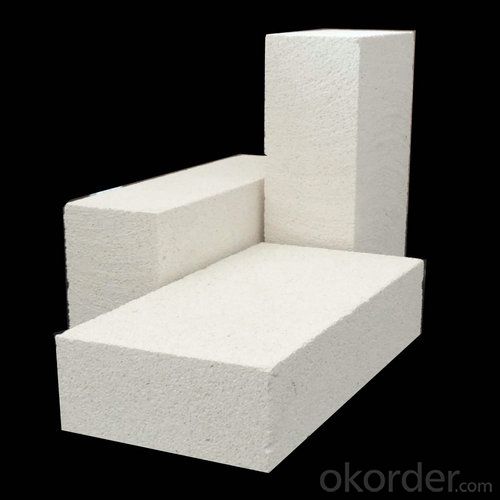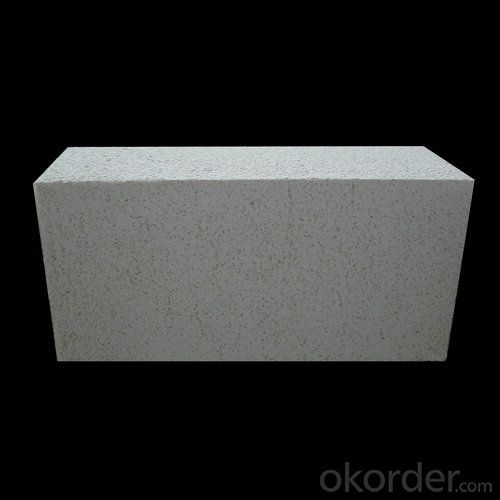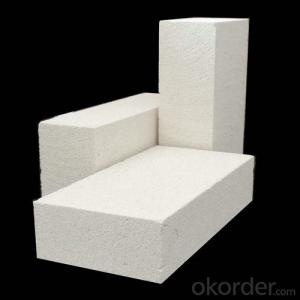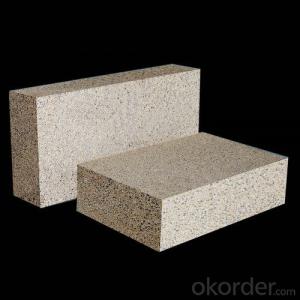Insulating Brick GJM30 in Lightweight Fireclay Made in China
- Loading Port:
- Tianjin
- Payment Terms:
- TT OR LC
- Min Order Qty:
- 1 m.t.
- Supply Capability:
- 20000 m.t./month
OKorder Service Pledge
OKorder Financial Service
You Might Also Like
Description of Insulating Brick
CMAX Insulating Brick are classified under temperature between 1300℃ to 1700℃, manufactured from high purity alumina clay.
Features of Insulating Brick
Light weight and low thermal conductivity
Low heat storage
Low iron and impurities
High thermal shock resistance
Specifications for Insulating Fire Brick
Applications of Insulating Brick
CMAX Insulating Brick can be used as a hot face lining directly exposed to the heat or as a backup insulation layer in iron and steel mills, non-ferrous foundries, petrochemical, ceramic, glass.
Specifications of Insulating Brick
Type No. |
Density |
Compressive Strength |
Rupture Strength | % Linear Change on Reheating | Thermal Shock Resistance, Times | Heat Conductive Cofficient | Al2O3 | Fe2O3 |
DJM-23 | 0.60 | 1.3 | 1.0 | 1230×12-0.5 | ≥20 | 400°C0.15 | 40 | 0.70 |
DJM-26 | 0.80 | 1.8 | 1.4 | 1400×12-0.5 | >20 | 600°C0.25 | 55 | 0.70 |
DJM-28 | 0.90 | 2.2 | 1.7 | 1510×12-1.0 | >20 | 600°C0.34 | 65 | 0.60 |
DJM-30 | 1.0 | 2.50 | 2.10 | 1600×12-1.0 | >20 | 600°C0.43 | 74 | 0.50 |
DJM-32 | 1.2 | 3.50 | 2.50 | 1650×12-1.0 | >20 | 600°C0.50 | 76 | 0.40 |
Images of Insulating Brick


FAQ of Insulating Brick
1. Which products do you have?
We have all kinds of refractory brick, castable, mortar, cement, ceramic fiber products, etc.
Or you could browse our products to choose what you need.
2. Can you give me a general idea of the specification and technical data of your products?
CNBM offer a range of refractory and insulation products. We provide refractory bricks, monolithic refractories as well as ceramic fiber products. And On your given shapes, drawings or description, we are producing refractories with all sizes and shapes, resistant to temperature from 800 °C till 1800 °C, using various machines and equipments for cutting, grinding, drilling, polishing, shaping processes.
Every refractory product by CNBM is of superior quality. Lesser refractory products can not approach. CNBM utilizes proprietary testing methods, testing for chemical content, density, apparent porosity, cold crush strength and modulus of rapture. With stringent quality control, you can count on CNBM products to exceed refractory industry standards and your expectations.
3. Can you give me a brief introduction of the application of your products?
We are mainly specializing in the refractory materials in iron and steel, cement, glass, ceramics, petrochemical, electric power Industry, etc.
4. If I need your offer, what information do you need?
In order to choose suitable products, it will be appreciated to provide us the information, such us specification, technical data, order quantity, products application etc.
If any question, please contact us freely.
- Q:Can insulating fire bricks be used for insulation in steam boilers?
- Yes, insulating fire bricks can be used for insulation in steam boilers. These bricks are specifically designed to withstand high temperatures and provide excellent thermal insulation properties. They help to reduce heat loss and improve the overall energy efficiency of the steam boiler system.
- Q:What is the recommended thickness of insulating fire bricks for optimal insulation?
- The recommended thickness of insulating fire bricks for optimal insulation can vary depending on the specific application and desired level of thermal protection. However, in general, insulating fire bricks with a thickness ranging from 2.5 to 4 inches (6.35 to 10.16 cm) are commonly recommended for achieving efficient insulation. Insulating fire bricks are designed to have low thermal conductivity, which means they are able to effectively minimize heat transfer. The thicker the bricks, the higher the insulating properties as they provide a greater barrier against thermal energy loss or gain. This is particularly important in applications where maintaining a stable temperature is crucial, such as in industrial furnaces, kilns, or high-temperature appliances. It is important to consider the specific requirements of the insulation project and consult with experts or manufacturers to determine the most suitable thickness for the insulating fire bricks. Factors such as the maximum temperature, duration of exposure, and desired energy efficiency should be taken into account to ensure optimal insulation performance.
- Q:Can insulating fire bricks be used for insulation in flues?
- Yes, insulating fire bricks can be used for insulation in flues. These bricks are designed to withstand high temperatures and provide excellent thermal insulation, making them suitable for lining and insulating flue systems. They help to prevent heat loss, improve energy efficiency, and enhance the overall performance of the flue.
- Q:Can insulating fire bricks be used in the construction of smelting ovens?
- Yes, insulating fire bricks can be used in the construction of smelting ovens. They have excellent thermal insulation properties, high temperature resistance, and can withstand the intense heat generated during the smelting process. This makes them an ideal choice for lining the walls and floors of smelting ovens to maintain high temperatures and minimize heat loss.
- Q:Do insulating fire bricks have a low density?
- Yes, insulating fire bricks typically have a low density compared to other types of bricks.
- Q:Can insulating fire bricks be used in residential applications, such as fireplaces or ovens?
- Yes, insulating fire bricks can be used in residential applications such as fireplaces or ovens. Insulating fire bricks are designed to withstand high temperatures and provide excellent insulation, making them suitable for use in these applications. They help retain heat, improve energy efficiency, and enhance safety by preventing heat transfer to surrounding structures.
- Q:How do insulating fire bricks affect the overall energy consumption of a building?
- Insulating fire bricks can significantly reduce the overall energy consumption of a building by providing better insulation. These bricks have low thermal conductivity, which means they are effective in preventing heat transfer through walls and other surfaces. By minimizing heat loss during cold weather and heat gain during hot weather, insulating fire bricks help maintain a stable indoor temperature, reducing the need for heating and cooling systems. This results in lower energy usage and cost savings for the building's occupants.
- Q:Can insulating fire bricks be used in the construction of ovens or kilns for pottery?
- Yes, insulating fire bricks can be used in the construction of ovens or kilns for pottery. These bricks are designed to withstand high temperatures and provide excellent insulation, making them suitable for creating a stable and efficient heat environment required for pottery firing.
- Q:Are insulating fire bricks resistant to insects and rodents?
- Insulating fire bricks do not have a specific design to resist insects and rodents. Although these bricks are mainly utilized for their exceptional thermal insulation properties in high-temperature settings like furnaces and kilns, they lack inherent resistance against pests. In case you have worries about insects or rodents, it is advisable to incorporate supplementary pest control methods such as sealing gaps or cracks and employing suitable pest deterrents.
- Q:Are insulating fire bricks suitable for use in glass furnaces?
- Yes, insulating fire bricks are indeed suitable for use in glass furnaces. These fire bricks are specifically designed to withstand high temperatures and provide excellent thermal insulation. They help to maintain consistent heat levels within the furnace, prevent heat loss, and reduce energy consumption. Additionally, insulating fire bricks are resistant to chemical reactions and can withstand the corrosive environment of a glass furnace.
1. Manufacturer Overview |
|
|---|---|
| Location | |
| Year Established | |
| Annual Output Value | |
| Main Markets | |
| Company Certifications | |
2. Manufacturer Certificates |
|
|---|---|
| a) Certification Name | |
| Range | |
| Reference | |
| Validity Period | |
3. Manufacturer Capability |
|
|---|---|
| a)Trade Capacity | |
| Nearest Port | |
| Export Percentage | |
| No.of Employees in Trade Department | |
| Language Spoken: | |
| b)Factory Information | |
| Factory Size: | |
| No. of Production Lines | |
| Contract Manufacturing | |
| Product Price Range | |
Send your message to us
Insulating Brick GJM30 in Lightweight Fireclay Made in China
- Loading Port:
- Tianjin
- Payment Terms:
- TT OR LC
- Min Order Qty:
- 1 m.t.
- Supply Capability:
- 20000 m.t./month
OKorder Service Pledge
OKorder Financial Service
Similar products
New products
Hot products
Related keywords





























